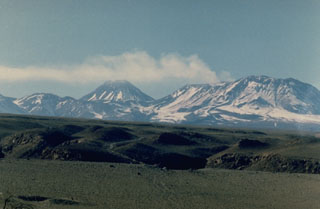Report on Lascar (Chile) — March 1990
Bulletin of the Global Volcanism Network, vol. 15, no. 3 (March 1990)
Managing Editor: Lindsay McClelland.
Lascar (Chile) 20 February eruption ejected about 10-30% of the lava dome in crystal-rich fragments
Please cite this report as:
Global Volcanism Program, 1990. Report on Lascar (Chile) (McClelland, L., ed.). Bulletin of the Global Volcanism Network, 15:3. Smithsonian Institution. https://doi.org/10.5479/si.GVP.BGVN199003-355100
Lascar
Chile
23.37°S, 67.73°W; summit elev. 5592 m
All times are local (unless otherwise noted)
After the 20 February eruption, Lascar returned to its normal fumarolic activity with the generation of mainly white plumes that rise 300-500 m above the rim of the active central crater. Between 20 and 24 March, geologists from the SERNAGEOMIN and several British universities observed the volcano from the ground and from the active crater's rim, reached on the 23rd from the N slope and on the 24th from the S slope. The following is from their report.
"Examination of photographs taken by J.R. Gerneck (Chile Hunt Oil) during the 20 February eruption revealed three discrete plumes. The first, white in color, consisted mainly of steam, and was overtaken by two smaller, grayish, higher velocity clouds. Geologists interpreted this sequence as an initial steam explosion related to the partial destruction of the dome that fills the bottom of the active crater, followed by phreatomagmatic eruptions. The eruption products, primarily fragments of the dome, occurred as shattered, dark, dense blocks of porphyritic pyroxene andesite, ranging to white, semi-vesicular, largely disaggregated blocks of similar composition, with thin, darker, quenched rims. The blocks were composed of plagioclase, clinopyroxene, and orthopyroxene phenocrysts, small amounts of magnetite, and scarce reacted olivine and hornblende crystals in a glassy groundmass. They are enriched in crystals compared to bombs from the 1986 eruption, with larger phenocrysts (up to 2 mm), and a larger proportion of pyroxene. No olivine or hornblende were found in the 1986 bombs, which included occasional xenoliths of partially molten granite. The 20 February blocks were distributed almost symmetrically in a radius of 4 km around the crater, associated with asymmetrical impact craters, elongate parallel to block trajectories. The number of blocks increased dramatically close to the vent where they covered 70-90% of the surface. No fresh ash was observed close to the volcano.
"Preliminary calculations, based on the volume of ejecta and the size of the plume, indicate that between 10 and 30% of the dome was erupted on 20 February. This estimate is supported by 5 March airphotos of the interior of the crater and by observations made from the crater rim, where a large part of the dome can still be observed in the bottom of the crater. The dome has apparently continued deflating since our last observation in November 1989 (14:11). A hole appeared to be present in its center, produced by collapse into the vent. Fumaroles were located around the dome, along ring fractures as observed in April 1989. Gas was still venting at extremely high velocity, creating the same jet-like noise reported in November. The strongest fumaroles were on the dome's NE and SW edges. A strong smell of HCl and SO2 was recorded from the N rim. Deposits of yellow sulfur are visible associated with the fumaroles. Temperatures were measured (by Clive Oppenheimer) using an infrared radiometer (after dark, to eliminate the effects of sunlight). The fumaroles were observed to be glowing red hot and bright spots were seen over the dome. Preliminary data show the largest fumarole to have a temperature of 700-800°C, while the surface of the dome had an average temperature of 100-200°."
Geological Summary. Láscar is the most active volcano of the northern Chilean Andes. The andesitic-to-dacitic stratovolcano contains six overlapping summit craters. Prominent lava flows descend its NW flanks. An older, higher stratovolcano 5 km E, Volcán Aguas Calientes, displays a well-developed summit crater and a probable Holocene lava flow near its summit (de Silva and Francis, 1991). Láscar consists of two major edifices; activity began at the eastern volcano and then shifted to the western cone. The largest eruption took place about 26,500 years ago, and following the eruption of the Tumbres scoria flow about 9000 years ago, activity shifted back to the eastern edifice, where three overlapping craters were formed. Frequent small-to-moderate explosive eruptions have been recorded since the mid-19th century, along with periodic larger eruptions that produced ashfall hundreds of kilometers away. The largest historical eruption took place in 1993, producing pyroclastic flows to 8.5 km NW of the summit and ashfall in Buenos Aires.
Information Contacts: M. Gardeweg, SERNAGEOMIN, Santiago; S. Matthews, Univ College London; C. Oppenheimer, Open Univ; S. Sparks and M. Stasiuk, Univ of Bristol.

